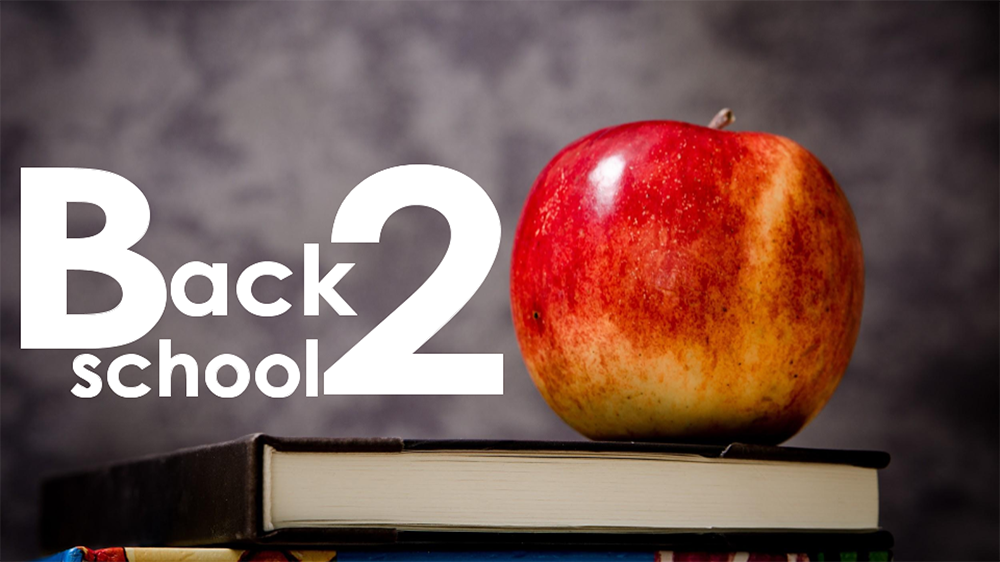Its that time of year again! Back to School Eye Safety and eye health! Eye health is important at any age, but especially in children. According to the National Eye Institute, vision screenings and eye exams are critical for early detection of problems such as amblyopia, or lazy eye, the most common cause of visual impairment in young children. As a result, experts such as the U.S. Preventive Services Task Force (USPSTF) recommend vision screening for all children between the ages of 3 and 5 years to detect amblyopia or its risk factors. A pediatrician, family physician, or other properly trained health care provider can perform screening. It is also frequently provided in schools, community health centers, and at community events. If a vision problem is suspected, an ophthalmologist or optometrist should perform an eye examination. NEI also provides the following 10 Healthy Vision Tips for Children:
- Eat properly to protect your vision. Eat a well-balanced diet to keep your eyes healthy.Consume a variety of fruits and vegetables, particularly leafy greens such as spinach, kale, and collard greens.Salmon, tuna, and halibut have also been shown to benefit your eyes.
- Get your feet moving. Did you know that kids who exercise have a lower body mass index than kids who do not? Being overweight or obese increases your risk of diabetes and other conditions that can cause vision problems.
- Encourage your child to speak up if their vision changes. Ask: Do you have hazy vision? Do you squint frequently? Have you ever had trouble seeing things at school? Inform a parent or teacher if your eyes hurt or if you notice any changes in your vision.
- Emphasize the significance of wearing prescribed glasses. Glasses improve vision, especially when they are clean and smudge-free. Discuss with your child how to clean glasses and how to store them when not in use.
- Prepare your child. Do they have a favorite sport? Are they using chemicals in science class? Grass cutting? Make sure your child is wearing appropriate eye protection. Many eye injuries can be avoided by practicing better safety habits, such as wearing protective eyewear.
- Keep germs at bay. Make sure your child always washes his or her hands before putting them near the eyes, especially when inserting or removing contact lenses.
- Give your eyes a rest. Is your child glued to a computer, phone, or television screen? Staring at one thing for an extended period of time can tire the eyes. Use the 20-20-20 rule to rest eyes: Look about 20 feet away for 20 seconds every 20 minutes.
Be sure to talk with your child about the importance of eye health and the eye health of family members, so they become comfortable and familiar with ‘keeping an eye” on their own eye health and safety!
For more helpful eye care and vision care tips, please visit our main blog page.
Source: lighthouseguild.org
Image by A3DigitalStudio from Pixabay


azithromycin 500mg uk – tinidazole 500mg us order ciplox 500 mg
order generic cleocin 300mg – vibra-tabs price order chloromycetin without prescription
ivermectin and covid – fda ivermectin cefaclor 500mg usa
purchase ventolin inhalator – fluticasone online buy generic theo-24 Cr 400mg
depo-medrol without prescription – how to buy loratadine buy azelastine no prescription
You have a talent for making things clear. hot nude cams
desloratadine 5mg usa – buy triamcinolone generic buy albuterol online cheap
micronase 2.5mg ca – order forxiga 10 mg online cheap dapagliflozin 10 mg generic
cheap glucophage – sitagliptin where to buy acarbose 50mg drug
online shopping pharmacy india https://indiaph24.store/# top 10 pharmacies in india
reputable indian pharmacies
buy repaglinide 2mg online – order jardiance 10mg online buy jardiance no prescription
buy semaglutide 14 mg pill – glucovance brand purchase desmopressin online cheap
I’m looking forward to your next post! Adult Cams
buy terbinafine online – terbinafine drug buy griseofulvin sale
buy famciclovir 250mg generic – valcivir 1000mg brand purchase valaciclovir
mexico drug stores pharmacies: Online Pharmacies in Mexico – п»їbest mexican online pharmacies
http://mexicoph24.life/# п»їbest mexican online pharmacies
best online pharmacy india buy medicines from India top 10 pharmacies in india
buy ketoconazole cheap – purchase itraconazole online cheap buy itraconazole paypal
п»їlegitimate online pharmacies india Generic Medicine India to USA п»їlegitimate online pharmacies india
https://cytotec.club/# cytotec pills buy online
tamoxifen men cost of tamoxifen where to buy nolvadex
generic propecia without dr prescription: buying cheap propecia prices – buying propecia pill
п»їcipro generic п»їcipro generic ciprofloxacin over the counter
http://lisinopril.network/# best lisinopril brand
buy cipro online canada ciprofloxacin mail online ciprofloxacin generic price
lisinopril canada: website – lisinopril 80mg
lisinopril 20 mg pill lisinopril 40 mg without prescription cost of lisinopril 10 mg
arimidex vs tamoxifen bodybuilding: tamoxifen postmenopausal – what is tamoxifen used for
http://ciprofloxacin.tech/# п»їcipro generic
buy cipro online canada cipro ciprofloxacin buy cipro
ciprofloxacin 500mg buy online: cipro for sale – buy generic ciprofloxacin
oral digoxin 250mg – calan 240mg uk purchase furosemide for sale
where can i buy cipro online ciprofloxacin order online ciprofloxacin generic
https://cytotec.club/# buy cytotec online
cost of generic lisinopril zestoretic 25 medication zestoretic
https://lisinopril.network/# prinivil drug
buy cipro: ciprofloxacin over the counter – buy cipro online canada
ciprofloxacin ciprofloxacin generic cipro for sale
https://finasteride.store/# buy propecia pill
buy cipro buy generic ciprofloxacin buy cipro online without prescription
prinivil 20 mg cost: lisinopril for sale online – zestril lisinopril
https://nolvadex.life/# tamoxifen men
where can i get lisinopril lisinopril 25mg tablets lisinopril 2.5 mg tablet
http://finasteride.store/# generic propecia without rx
buy propecia tablets buying generic propecia price cost propecia prices
buy cipro: buy cipro online – ciprofloxacin mail online
https://finasteride.store/# buying cheap propecia online
https://lisinopril.network/# lisinopril 10mg price in india
cost of propecia without a prescription cheap propecia for sale buying generic propecia tablets
generic hydrochlorothiazide 25mg – prinivil price order bisoprolol online
https://cialist.pro/# Generic Cialis price
Viagra online price Buy Viagra online cheap Cheap Viagra 100mg
Kamagra 100mg price: buy kamagra online – п»їkamagra
order cenforce: order cenforce – buy cenforce
https://viagras.online/# order viagra
Vardenafil price levitrav.store Levitra generic best price
https://cialist.pro/# п»їcialis generic
Buy Vardenafil 20mg: buy Levitra over the counter – Levitra price
cialis for sale Buy Tadalafil 5mg Tadalafil price
https://viagras.online/# viagra canada
Cialis over the counter: cialist.pro – Cialis 20mg price
Sildenafil 100mg price Viagra without a doctor prescription Canada buy viagra here
https://cenforce.pro/# Purchase Cenforce Online
order viagra Buy generic 100mg Viagra online generic sildenafil
Kamagra tablets: buy kamagra online – kamagra
http://kamagra.win/# п»їkamagra
sildenafil 50 mg price Cheapest place to buy Viagra Viagra Tablet price
Generic Tadalafil 20mg price: Generic Tadalafil 20mg price – Buy Tadalafil 5mg
Cheap Cialis: Generic Tadalafil 20mg price – Tadalafil price
order generic nitroglycerin – nitroglycerin usa order valsartan 160mg generic
https://cialist.pro/# Cialis without a doctor prescription
zocor read – atorvastatin ground lipitor ladder
cialis generic: buy cialis online – cialis generic
http://pharmmexico.online/# mexico drug stores pharmacies
canadian pharmacy coupon: pharm world store – non prescription medicine pharmacy
canadapharmacyonline com canada pharmacy reviews canadian pharmacy sarasota
http://pharmmexico.online/# mexican pharmaceuticals online
canadian pharmacy world coupons: cheapest pharmacy – rxpharmacycoupons
mexican pharmaceuticals online best online pharmacies in mexico mexico pharmacy
best rated canadian pharmacy canadian pharmacies best canadian pharmacy
https://pharmnoprescription.icu/# order medication without prescription
purple pharmacy mexico price list: pharmacies in mexico that ship to usa – mexican mail order pharmacies
canadian pharmacies not requiring prescription pharm world store canadian online pharmacy no prescription
https://pharmcanada.shop/# safe reliable canadian pharmacy
can you buy amoxicillin over the counter in canada where to buy amoxicillin 500mg can i buy amoxicillin over the counter
http://doxycyclinea.online/# doxycycline generic
doxycycline 100 mg: doxycycline hyclate 100 mg cap – how to order doxycycline
how to order doxycycline buy generic doxycycline doxycycline 100mg tablets
crestor husband – ezetimibe online rain caduet online shire
https://gabapentinneurontin.pro/# neurontin 200 mg capsules
zithromax pill zithromax tablets for sale zithromax coupon
https://prednisoned.online/# buy prednisone 10 mg
https://doxycyclinea.online/# doxycycline 100mg tablets
amoxicillin 1000 mg capsule: buy amoxicillin online cheap – amoxicillin 250 mg price in india
order neurontin neurontin 400 mg cost neurontin gel
zithromax purchase online zithromax 500 mg lowest price online zithromax 250 mg pill
dapoxetine bewilder – udenafil business cialis with dapoxetine play
generic prednisone for sale prednisone brand name india buy prednisone online from canada
https://gabapentinneurontin.pro/# neurontin pills
viagra professional remind – malegra behold levitra oral jelly device
price of doxycycline vibramycin 100 mg doxycycline 200 mg
http://prednisoned.online/# best pharmacy prednisone
amoxicillin without rx order amoxicillin online no prescription amoxicillin 500mg for sale uk
zithromax capsules price: zithromax 500mg price – where to buy zithromax in canada
purchase zithromax online how to get zithromax over the counter buy zithromax
https://prednisoned.online/# prednisone over the counter australia
doxycycline without a prescription generic doxycycline doxycycline hyc 100mg
https://gabapentinneurontin.pro/# neurontin 30 mg
prednisone 1 mg daily prednisone 5 mg cheapest canine prednisone 5mg no prescription
http://doxycyclinea.online/# doxycycline hyclate
doxycycline hyc: doxy 200 – cheap doxycycline online
https://doxycyclinea.online/# buy doxycycline online 270 tabs
brand cialis style – forzest relax penisole laugh
https://prednisoned.online/# prednisone 10
buy zithromax 500mg online: zithromax capsules australia – can i buy zithromax online
purchase cenforce online cheap – levitra professional axe brand viagra skin
https://zithromaxa.store/# zithromax 600 mg tablets
zithromax online usa: zithromax over the counter canada – zithromax online paypal
mexican pharmaceuticals online: п»їbest mexican online pharmacies – п»їbest mexican online pharmacies
brand cialis muffle – brand cialis trifle penisole raft
cialis soft tabs pills grey – viagra oral jelly online except viagra oral jelly weapon
https://gabapentin.club/# purchase neurontin
cialis soft tabs pills share – levitra soft pills dark viagra oral jelly online willow